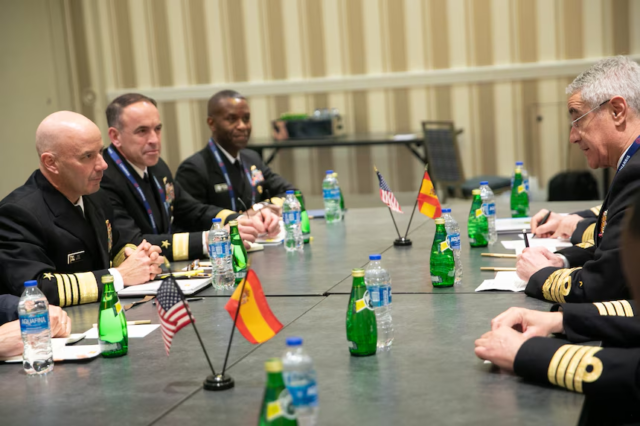Published on AyroTV.com | April 15, 2025

A recent statement from the new U.S. Navy Chief, Admiral James Kilby, has sparked discussions about the military’s approach to countering Houthi threats in the Red Sea. In a Defense News article published on April 6, 2023, Admiral Kilby expressed regret over the use of expensive missile interceptors to counter Houthi unmanned aerial vehicles (UAVs). He highlighted the need for more cost-effective defense strategies, stating, “I had not been thoughtful enough to think about the UAV threat where I think a much lesser-powered weapon would have done what we needed it to do.”
Background: U.S. Military Spending in the Red Sea
The Defense News piece, titled “New Navy chief ‘regrets’ costly missile interceptors against Houthis, pushes for cheaper Red Sea defense,” sheds light on the U.S. Navy’s ongoing operations against Houthi forces in the Red Sea. The Houthis, a Yemen-based militant group, have been launching UAVs and other attacks on military and civilian targets in the region, particularly since the escalation of conflict following October 7, 2023. The U.S. has been a key player in maintaining regional defense, deploying its first carrier to the area on a year-long mission—a conservative estimate compared to the more aggressive actions of the Houthis, whose activities have cost the U.S. over $1 billion.
The article emphasizes that the U.S. has been spending at least $2.4 billion annually on regional defense in the Red Sea. This figure includes the deployment of advanced missile interceptors, which are significantly more expensive than the threats they counter. Admiral Kilby’s statement reflects a growing concern within the military about the sustainability of such high-cost defenses, especially when dealing with relatively low-cost UAVs deployed by the Houthis.
Combat Pay, Tax Benefits, and Financial Strain
The Defense News article also highlights the financial burden on U.S. military personnel deployed in the region. Military members receive combat pay and tax exclusion benefits (CZTE) for each month or part of a month they are stationed in hostile areas. Given the incremental deployment of U.S. personnel to the Red Sea since October 7, 2023, this has resulted in an additional cost of $55–$70 million. These benefits, while crucial for supporting troops, add to the overall financial strain of the operation.
Houthi Operations and Global Impact
The Houthis’ activities have not only targeted U.S. forces but have also disrupted global shipping and financial operations. The U.S. Treasury’s Office of Foreign Assets Control (OFAC) has imposed sanctions on multiple shipping and financial operators linked to Houthi activities, including vessels operating in the Red Sea. These sanctions aim to curb the Houthis’ ability to fund their operations, which have significantly impacted international trade routes in the region.
A Call for Cost-Effective Solutions
Admiral Kilby’s remarks signal a potential shift in U.S. military strategy. The high cost of missile interceptors—often priced in the millions per unit—has been a point of contention when used against relatively inexpensive Houthi drones, which can cost as little as a few thousand dollars to produce. Kilby advocates for the development and deployment of “lesser-powered” weapons that can effectively neutralize UAV threats without draining military budgets. This could include directed-energy weapons, such as lasers, or smaller, more affordable missile systems designed specifically for low-cost threats.
The push for cheaper defense solutions comes at a time when the U.S. military is already grappling with budget constraints and the need to modernize its forces. The Red Sea conflict, while a small part of the broader geopolitical landscape, serves as a testing ground for new strategies that could be applied to other theaters of operation.
Implications for Future Naval Operations
The acknowledgment of this strategic oversight by Admiral Kilby could have far-reaching implications for U.S. naval operations. As UAV technology becomes more accessible to non-state actors like the Houthis, the U.S. military will need to adapt its defense mechanisms to remain both effective and financially sustainable. The development of cost-effective countermeasures could also influence how the U.S. supports its allies in the region, many of whom face similar threats from drone attacks.
Conclusion
The U.S. Navy’s reflection on its Red Sea operations underscores the evolving nature of modern warfare, where asymmetric threats like UAVs challenge traditional military spending models. Admiral James Kilby’s call for cheaper defense solutions highlights the need for innovation in military technology and strategy. As the U.S. continues to navigate its role in the Red Sea and beyond, balancing cost, effectiveness, and troop support will remain a critical priority.
For more updates on military strategies and global conflicts, stay tuned to AyroTV.com.









